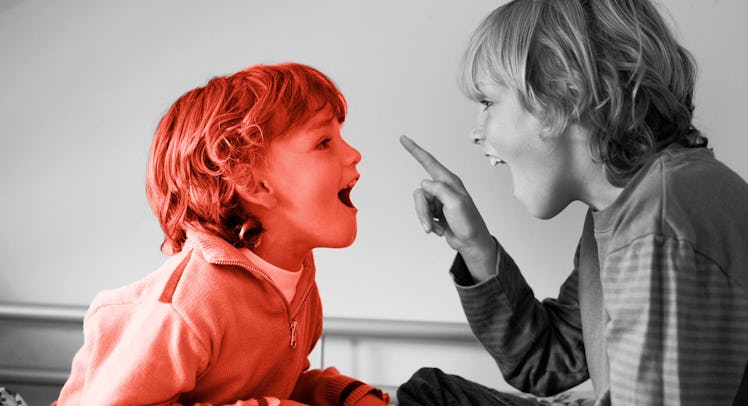How to Tell When Sibling Mimicry is Becoming a Problem
Mimicry can be a great way for kids to learn about the world, but when it’s done for attention parents should step in and make an effort to redirect.

It’s not for nothing that “Follow the Leader” and “Simon Says” hold a deep appeal for the under-5 set. Children are enthusiastic about mimicry in all its forms because it helps them connect with others and learn about their place in the world. That said, when siblings are suddenly caught in a battle of “Stop copying me!” the fun can quickly fade, leaving everyone frazzled, frustrated, and confused. If mimicry is healthy up to a point, how can parents tell when that point has been passed? Unfortunately, the answer probably isn’t instinct.
READ MORE: The Fatherly Guide to Raising Brothers and Sisters
“We have a skewed view of learning — that it’s about teaching and content and filling heads,” explains Dr. Robert Zeitlin, psychologist and author of author of Laugh More, Yell Less: A Guide to Raising Kick-Ass Kids. “And then we complain that kids don’t have a growth mindset and they’re not creative and curious, when in fact they start that way.”
Zeitlin notes that mimicry is part of the curiosity-driven creative learning process. He cites psychologist and social cognitive theorist Albert Bandura’s theory of social learning. “A kid will pick up a book before they can read and mimic what it’s like to read,” Zeitlin says. “They’re seeing siblings who are doing things they want to figure out how to do. So they’re starting out by mimicking that behavior so they can eventually get there.” Parents might not think about that behavior as being part of the process of learning to read, but it is.
In other words, while parents may believe a copycat sibling is troublesome, there’s likely a very good and productive reason for the behavior. And in fact, there’s no need to change it. That is unless the context of the behavior changes. Which it can.
“Sometimes younger siblings are looking for attention from an older sibling in ways that hurt them,” Zeitlin says. This is essentially a process of searching for “negative attention.” The idea is that an investment in being a jerk has a tendency to pay dividends in interaction. In fact, it’s a better bet than being recognized for being a sweet kid.
“If the purpose of the mimicry is to seek attention then it may take a little bit more effort on the parent’s part to provide that attention,” Zeitlin explains.”Spend a little solo time with the child and focus on what the kid wants to do.” This should redirect the energy away from mimicry while helping them build interest in something more productive, like mimicking how dad builds with Legos.
“Look at it like a scientist and break down the ABC of behavior — the antecedent, the behavior, and the consequence,” says Zeitlin. “You can start to see what might be the purpose for the behavior.”
And if that purpose is to turn a sibling into an angry whining mess? Well, then, it’s time for Simon to say “stop it.”
This article was originally published on